The Spatiotemporal Dynamics of Facial Movements Reveals the Left Side of a Posed Smile
Abstract
:Simple Summary
Abstract
1. Introduction
2. General Methods
2.1. Ethics Statement
2.2. Apparatus
2.3. Procedure
2.4. Expression Extraction and FACS Validation Procedure
2.5. Data Acquisition
2.5.1. Kinematic 3-D Tracking
2.5.2. Kinematic 3-D Analysis
- Lower part of the face:
- Left cheilion and the tip of the nose (Left-CH);
- Right cheilion and the tip of the nose (Right-CH).
- Upper part of the face:
- Left eyebrow and the tip of the nose (Left-EB);
- Right eyebrow and the tip of the nose (Right-EB).
- Spatial parameters:
- Maximum Distance (MD, mm) is the maximum distance reached by the 3-D coordinates (x,y,z) of two markers.
- Delta Distance (DD, mm) is the difference between the maximum and the minimum distance reached by two markers, to account for functional and anatomical differences across participants.
- Velocity parameters:
- Maximum Velocity (MV, mm/s) is the maximum velocity reached by the 3-D coordinates (x,y,z) of each pair of markers. In the equation V = d/t, V is the velocity, d is the distance, and t is the time. The velocity of a pair of markers is calculated instant by instant as the displacement between the markers divided by the time required to make the displacement. The maximum velocity was the highest value of this equation and reflected the speed at which the two markers achieved maximum displacement in the minimum time (see Figure 3, blue line).
- Maximum Acceleration (MA, mm/s2) is the maximum acceleration reached by the 3-D coordinates (x,y,z) of each pair of markers. In the equation A = v/t, A is the acceleration, v is the velocity, and t is the time. Acceleration is calculated moment by moment as the rate of change of velocity of a pair of markers. The maximum acceleration was the highest value of this equation (see Figure 3, red dashed line).
- Maximum Deceleration (MDec, mm/s2): is the maximum deceleration reached by the 3-D coordinates (x,y,z) of each pair of markers. Deceleration is a negative acceleration and is calculated moment by moment as the rate of change of velocity of a pair of markers as their speed decreases. The maximum deceleration was the highest negative value of this equation, reported here in absolute value for graphical purposes (see Figure 3, red dashed line).
- Time to Maximum Distance (TMD%, the proportion of time at which a pair of markers reached a maximum distance, calculated from movement onset)
- Time to Maximum Velocity (TMV%, the proportion of time at which a pair of markers reached a peak velocity, calculated from movement onset)
- Time to Maximum Acceleration (TMA%, the proportion of time at which a pair of markers reached a peak acceleration, calculated from movement onset)
- Time to Maximum Deceleration (TMDec%, the proportion of time at which a pair of markers reached a peak deceleration, calculated from movement onset)
2.6. Statistical Approach
3. Experiment 1
3.1. Participants
3.2. Stimuli
3.3. Results
Repeated-Measures ANOVA
4. Experiment 2
4.1. Participants
4.2. Stimuli
4.3. Results
Repeated-Measures ANOVA
5. Comparison Analysis (Experiment 1 vs. 2)
Mixed ANOVA: Posed vs. Spontaneous, Left vs. Right, and Experiment 1 vs. 2
6. Discussion
6.1. Left vs. Right
6.2. Posed vs. Spontaneous
6.3. Emotional Induction vs. Motor Contagion
6.4. Clinical applications
7. Conclusions
Supplementary Materials
Author Contributions
Funding
Institutional Review Board Statement
Informed Consent Statement
Data Availability Statement
Acknowledgments
Conflicts of Interest
References
- Ekman, P. Lie Catching and Microexpressions. In The Philosophy of Deception; Martin, C.W., Ed.; Oxford University Press: New York, NY, USA, 2009; pp. 118–136. ISBN 978-0-19-532793-9. [Google Scholar]
- Koff, E.; Borod, J.; Strauss, E. Development of Hemiface Size Asymmetry. Cortex 1985, 21, 153–156. [Google Scholar] [CrossRef]
- Rinn, W.E. The Neuropsychology of Facial Expression: A Review of the Neurological and Psychological Mechanisms for Producing Facial Expressions. Psychol. Bull. 1984, 95, 52–77. [Google Scholar] [CrossRef]
- Morecraft, R.J.; Stilwell–Morecraft, K.S.; Rossing, W.R. The Motor Cortex and Facial Expression:: New Insights From Neuroscience. Neurologist 2004, 10, 235–249. [Google Scholar] [CrossRef]
- Ross, E.D.; Gupta, S.S.; Adnan, A.M.; Holden, T.L.; Havlicek, J.; Radhakrishnan, S. Neurophysiology of Spontaneous Facial Expressions: I. Motor Control of the Upper and Lower Face Is Behaviorally Independent in Adults. Cortex J. Devoted Study Nerv. Syst. Behav. 2016, 76, 28–42. [Google Scholar] [CrossRef] [PubMed]
- Morecraft, R.J.; Louie, J.L.; Herrick, J.L.; Stilwell-Morecraft, K.S. Cortical Innervation of the Facial Nucleus in the Non-Human Primate: A New Interpretation of the Effects of Stroke and Related Subtotal Brain Trauma on the Muscles of Facial Expression. Brain J. Neurol. 2001, 124, 176–208. [Google Scholar] [CrossRef] [PubMed]
- Gazzaniga, M.S.; Smylie, C.S. Hemispheric Mechanisms Controlling Voluntary and Spontaneous Facial Expressions. J. Cogn. Neurosci. 1990, 2, 239–245. [Google Scholar] [CrossRef]
- Hopf, H.C.; Md, W.M.-F.; Hopf, N.J. Localization of Emotional and Volitional Facial Paresis. Neurology 1992, 42, 1918. [Google Scholar] [CrossRef]
- Krippl, M.; Karim, A.A.; Brechmann, A. Neuronal Correlates of Voluntary Facial Movements. Front. Hum. Neurosci. 2015, 9, 598. [Google Scholar] [CrossRef] [PubMed]
- Ross, E.D.; Gupta, S.S.; Adnan, A.M.; Holden, T.L.; Havlicek, J.; Radhakrishnan, S. Neurophysiology of Spontaneous Facial Expressions: II. Motor Control of the Right and Left Face Is Partially Independent in Adults. Cortex 2019, 111, 164–182. [Google Scholar] [CrossRef]
- Demaree, H.A.; Everhart, D.E.; Youngstrom, E.A.; Harrison, D.W. Brain Lateralization of Emotional Processing: Historical Roots and a Future Incorporating “Dominance”. Behav. Cogn. Neurosci. Rev. 2005, 4, 3–20. [Google Scholar] [CrossRef]
- Killgore, W.D.S.; Yurgelun-Todd, D.A. The Right-Hemisphere and Valence Hypotheses: Could They Both Be Right (and Sometimes Left)? Soc. Cogn. Affect. Neurosci. 2007, 2, 240–250. [Google Scholar] [CrossRef] [PubMed]
- Davidson, R.J. Affect, Cognition, and Hemispheric Specialization. In Emotions, Cognition, and Behavior; Cambridge University Press: New York, NY, USA, 1985; pp. 320–365. ISBN 978-0-521-25601-8. [Google Scholar]
- Ross, E.D.; Prodan, C.I.; Monnot, M. Human Facial Expressions Are Organized Functionally Across the Upper-Lower Facial Axis. Neuroscientist 2007, 13, 433–446. [Google Scholar] [CrossRef] [PubMed]
- Straulino, E.; Scarpazza, C.; Sartori, L. What Is Missing in the Study of Emotion Expression? Front. Psychol. 2023, 14, 1158136. [Google Scholar] [CrossRef] [PubMed]
- Sackeim, H.A.; Gur, R.C.; Saucy, M.C. Emotions Are Expressed More Intensely on the Left Side of the Face. Science 1978, 202, 434–436. [Google Scholar] [CrossRef]
- Ekman, P.; Hager, J.C.; Friesen, W.V. The Symmetry of Emotional and Deliberate Facial Actions. Psychophysiology 1981, 18, 101–106. [Google Scholar] [CrossRef]
- Borod, J.C.; Cicero, B.A.; Obler, L.K.; Welkowitz, J.; Erhan, H.M.; Santschi, C.; Grunwald, I.S.; Agosti, R.M.; Whalen, J.R. Right Hemisphere Emotional Perception: Evidence across Multiple Channels. Neuropsychology 1998, 12, 446–458. [Google Scholar] [CrossRef]
- Borod, J.C.; Koff, E.; White, B. Facial Asymmetry in Posed and Spontaneous Expressions of Emotion. Brain Cogn. 1983, 2, 165–175. [Google Scholar] [CrossRef]
- Thompson, J.K. Right Brain, Left Brain; Left Face, Right Face: Hemisphericity and the Expression of Facial Emotion. Cortex J. Devoted Study Nerv. Syst. Behav. 1985, 21, 281–299. [Google Scholar] [CrossRef]
- Ross, E.D. Differential Hemispheric Lateralization of Emotions and Related Display Behaviors: Emotion-Type Hypothesis. Brain Sci. 2021, 11, 1034. [Google Scholar] [CrossRef]
- Duchenne de Boulogne, G.-B. The Mechanism of Human Facial Expression; Cuthbertson, R.A., Ed.; Studies in Emotion and Social Interaction; Cambridge University Press: Cambridge, UK, 1990; ISBN 978-0-521-36392-1. [Google Scholar]
- Ekman, P.; Friesen, W.V. Felt, False, and Miserable Smiles. J. Nonverbal Behav. 1982, 6, 238–252. [Google Scholar] [CrossRef]
- Ekman, P.; Friesen, W.V.; O’Sullivan, M. Smiles When Lying. J. Pers. Soc. Psychol. 1988, 54, 414–420. [Google Scholar] [CrossRef] [PubMed]
- Ross, E.D.; Pulusu, V.K. Posed versus Spontaneous Facial Expressions Are Modulated by Opposite Cerebral Hemispheres. Cortex 2013, 49, 1280–1291. [Google Scholar] [CrossRef] [PubMed]
- Barrett, L.F.; Adolphs, R.; Marsella, S.; Martinez, A.M.; Pollak, S.D. Emotional Expressions Reconsidered: Challenges to Inferring Emotion From Human Facial Movements. Psychol. Sci. Public Interest J. Am. Psychol. Soc. 2019, 20, 1–68. [Google Scholar] [CrossRef] [PubMed]
- Siedlecka, E.; Denson, T.F. Experimental Methods for Inducing Basic Emotions: A Qualitative Review. Emot. Rev. 2019, 11, 87–97. [Google Scholar] [CrossRef]
- Kavanagh, L.C.; Winkielman, P. The Functionality of Spontaneous Mimicry and Its Influences on Affiliation: An Implicit Socialization Account. Front. Psychol. 2016, 7, 458. [Google Scholar] [CrossRef]
- Prochazkova, E.; Kret, M.E. Connecting Minds and Sharing Emotions through Mimicry: A Neurocognitive Model of Emotional Contagion. Neurosci. Biobehav. Rev. 2017, 80, 99–114. [Google Scholar] [CrossRef]
- Rizzolatti, G.; Fogassi, L.; Gallese, V. Neurophysiological Mechanisms Underlying the Understanding and Imitation of Action. Nat. Rev. Neurosci. 2001, 2, 661–670. [Google Scholar] [CrossRef]
- Hess, U.; Fischer, A. Emotional Mimicry: Why and When We Mimic Emotions. Soc. Personal. Psychol. Compass 2014, 8, 45–57. [Google Scholar] [CrossRef]
- Straulino, E.; Scarpazza, C.; Miolla, A.; Spoto, A.; Betti, S.; Sartori, L. Different Induction Methods Reveal the Kinematic Features of Posed vs. Spontaneous Expressions. under review.
- Ekman, P.; Friesen, W. Facial Action Coding System: A Technique for the Measurement of Facial Movement; Consulting Psychologists Press: Palo Alto, CA, USA, 1978. [Google Scholar]
- Straulino, E.; Miolla, A.; Scarpazza, C.; Sartori, L. Facial Kinematics of Spontaneous and Posed Expression of Emotions. In Proceedings of the International Society for Research on Emotion—ISRE 2022, Los Angeles, CA, USA, 15–18 July 2022. [Google Scholar]
- Sowden, S.; Schuster, B.A.; Keating, C.T.; Fraser, D.S.; Cook, J.L. The Role of Movement Kinematics in Facial Emotion Expression Production and Recognition. Emot. Wash. DC 2021, 21, 1041–1061. [Google Scholar] [CrossRef]
- Zane, E.; Yang, Z.; Pozzan, L.; Guha, T.; Narayanan, S.; Grossman, R.B. Motion-Capture Patterns of Voluntarily Mimicked Dynamic Facial Expressions in Children and Adolescents With and Without ASD. J. Autism Dev. Disord. 2019, 49, 1062–1079. [Google Scholar] [CrossRef]
- Guo, H.; Zhang, X.-H.; Liang, J.; Yan, W.-J. The Dynamic Features of Lip Corners in Genuine and Posed Smiles. Front. Psychol. 2018, 9, 202. [Google Scholar] [CrossRef] [PubMed]
- Fox, D. The Scientists Studying Facial Expressions. Nature 2020. Online ahead of print. [Google Scholar] [CrossRef] [PubMed]
- Ekman, P.; Friesen, W.V. Pictures of Facial Affect; Consulting Psychologists Press: Palo Alto, CA, USA, 1976. [Google Scholar]
- Miolla, A.; Cardaioli, M.; Scarpazza, C. Padova Emotional Dataset of Facial Expressions (PEDFE): A Unique Dataset of Genuine and Posed Emotional Facial Expressions. Behav. Res. Methods 2022. [Google Scholar] [CrossRef] [PubMed]
- Le Mau, T.; Hoemann, K.; Lyons, S.H.; Fugate, J.M.B.; Brown, E.N.; Gendron, M.; Barrett, L.F. Professional Actors Demonstrate Variability, Not Stereotypical Expressions, When Portraying Emotional States in Photographs. Nat. Commun. 2021, 12, 5037. [Google Scholar] [CrossRef] [PubMed]
- Vimercati, S.L.; Rigoldi, C.; Albertini, G.; Crivellini, M.; Galli, M. Quantitative Evaluation of Facial Movement and Morphology. Ann. Otol. Rhinol. Laryngol. 2012, 121, 246–252. [Google Scholar] [CrossRef]
- Ceccarini, F.; Castiello, U. The Grasping Side of Post-Error Slowing. Cognition 2018, 179, 1–13. [Google Scholar] [CrossRef]
- JASP Team JASP-Version 0.16.4. Comput. Softw. 2022. Available online: https://jasp-stats.org/faq/how-do-i-cite-jasp/ (accessed on 18 July 2023).
- Sellke, T.; Bayarri, M.J.; Berger, J.O. Calibration of ρ Values for Testing Precise Null Hypotheses. Am. Stat. 2001, 55, 62–71. [Google Scholar] [CrossRef]
- Erdfelder, E.; Faul, F.; Buchner, A. GPOWER: A General Power Analysis Program. Behav. Res. Methods Instrum. Comput. 1996, 28, 1–11. [Google Scholar] [CrossRef]
- Sidequersky, F.V.; Mapelli, A.; Annoni, I.; Zago, M.; De Felício, C.M.; Sforza, C. Three-Dimensional Motion Analysis of Facial Movement during Verbal and Nonverbal Expressions in Healthy Subjects. Clin. Anat. 2016, 29, 991–997. [Google Scholar] [CrossRef]
- Gross, J.J.; Levenson, R.W. Emotion Elicitation Using Films. Cogn. Emot. 1995, 9, 87–108. [Google Scholar] [CrossRef]
- Ambadar, Z.; Cohn, J.F.; Reed, L.I. All Smiles Are Not Created Equal: Morphology and Timing of Smiles Perceived as Amused, Polite, and Embarrassed/Nervous. J. Nonverbal Behav. 2009, 33, 17–34. [Google Scholar] [CrossRef] [PubMed]
- Palomero-Gallagher, N.; Amunts, K. A Short Review on Emotion Processing: A Lateralized Network of Neuronal Networks. Brain Struct. Funct. 2022, 227, 673–684. [Google Scholar] [CrossRef] [PubMed]
- Morawetz, C.; Riedel, M.C.; Salo, T.; Berboth, S.; Eickhoff, S.B.; Laird, A.R.; Kohn, N. Multiple Large-Scale Neural Networks Underlying Emotion Regulation. Neurosci. Biobehav. Rev. 2020, 116, 382–395. [Google Scholar] [CrossRef] [PubMed]
- Schmidt, K.L.; Ambadar, Z.; Cohn, J.F.; Reed, L.I. Movement Differences between Deliberate and Spontaneous Facial Expressions: Zygomaticus Major Action in Smiling. J. Nonverbal Behav. 2006, 30, 37–52. [Google Scholar] [CrossRef]
- Schmidt, K.L.; Bhattacharya, S.; Denlinger, R. Comparison of Deliberate and Spontaneous Facial Movement in Smiles and Eyebrow Raises. J. Nonverbal Behav. 2009, 33, 35–45. [Google Scholar] [CrossRef]
- Kret, M.E.; De Gelder, B. A Review on Sex Differences in Processing Emotional Signals. Neuropsychologia 2012, 50, 1211–1221. [Google Scholar] [CrossRef]
- Smith, M.C.; Smith, M.K.; Ellgring, H. Spontaneous and Posed Facial Expression in Parkinson’s Disease. J. Int. Neuropsychol. Soc. JINS 1996, 2, 383–391. [Google Scholar] [CrossRef]
- Blandini, F.; Nappi, G.; Tassorelli, C.; Martignoni, E. Functional Changes of the Basal Ganglia Circuitry in Parkinson’s Disease. Prog. Neurobiol. 2000, 62, 63–88. [Google Scholar] [CrossRef]
- Alexander, G.E.; Crutcher, M.D. Functional Architecture of Basal Ganglia Circuits: Neural Substrates of Parallel Processing. Trends Neurosci. 1990, 13, 266–271. [Google Scholar] [CrossRef]
- McDonald, A.J. Organization of Amygdaloid Projections to the Prefrontal Cortex and Associated Striatum in the Rat. Neuroscience 1991, 44, 1–14. [Google Scholar] [CrossRef]
- Adolphs, R. Recognizing Emotion from Facial Expressions: Psychological and Neurological Mechanisms. Behav. Cogn. Neurosci. Rev. 2002, 1, 21–62. [Google Scholar] [CrossRef] [PubMed]
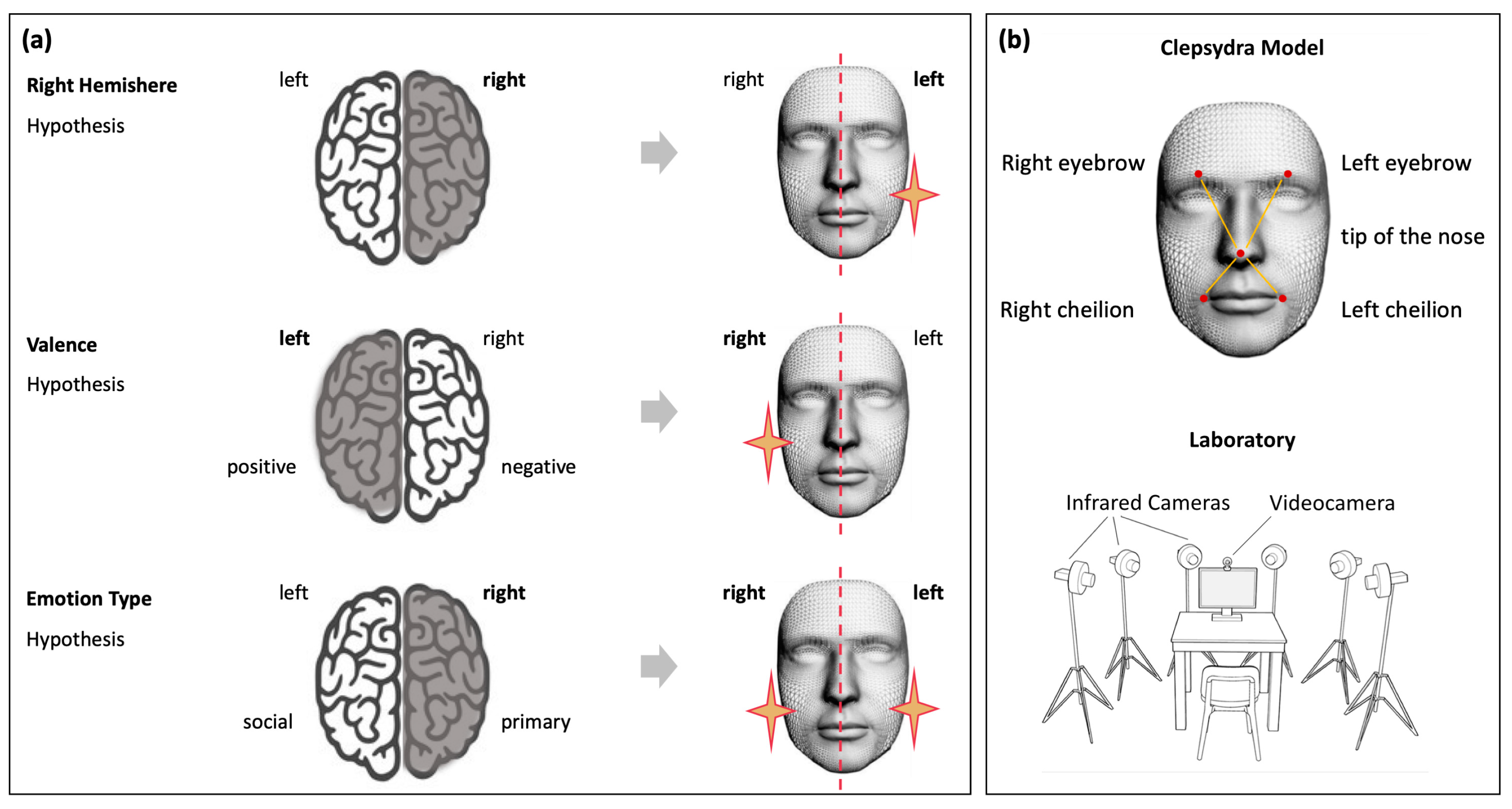
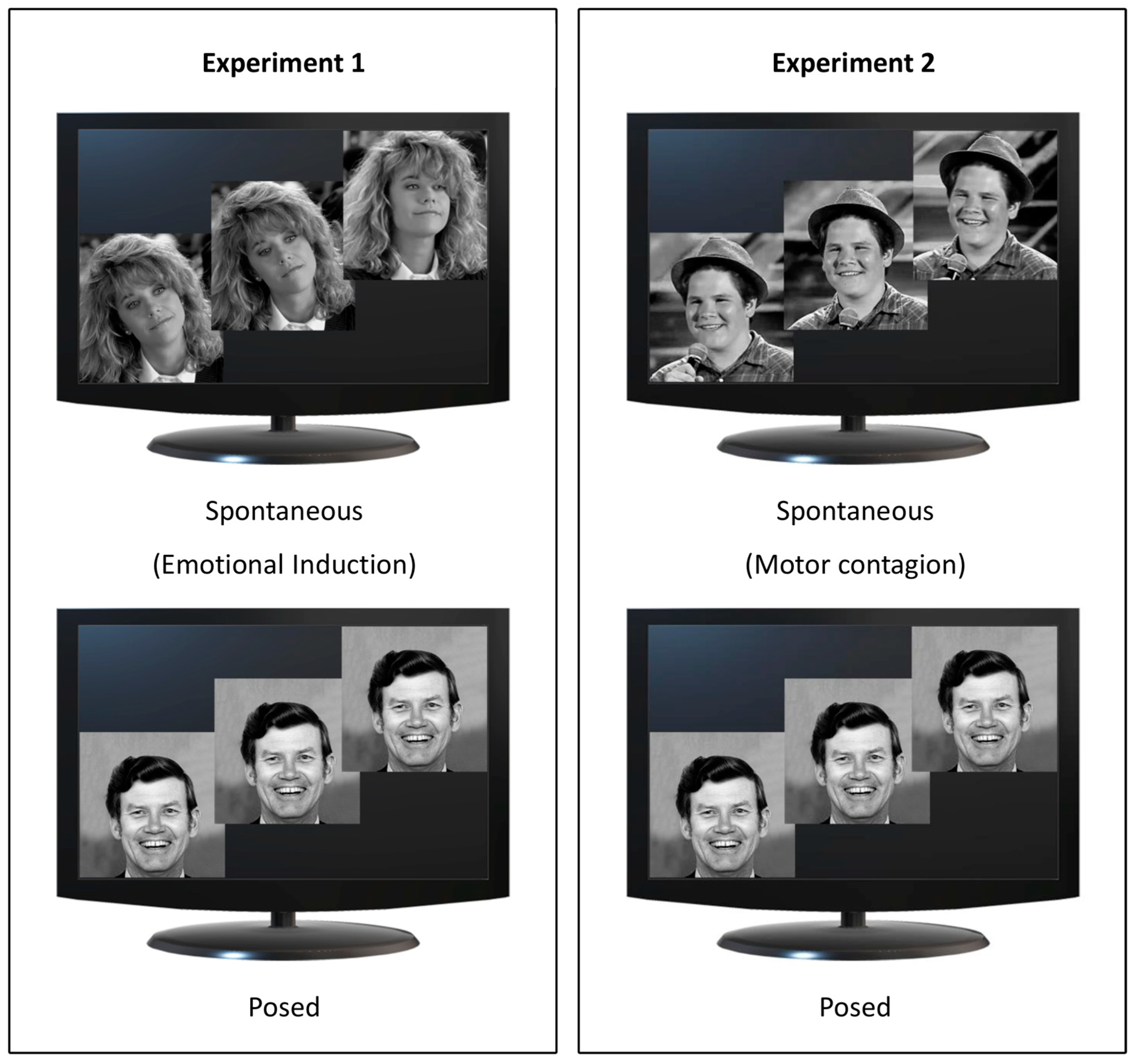

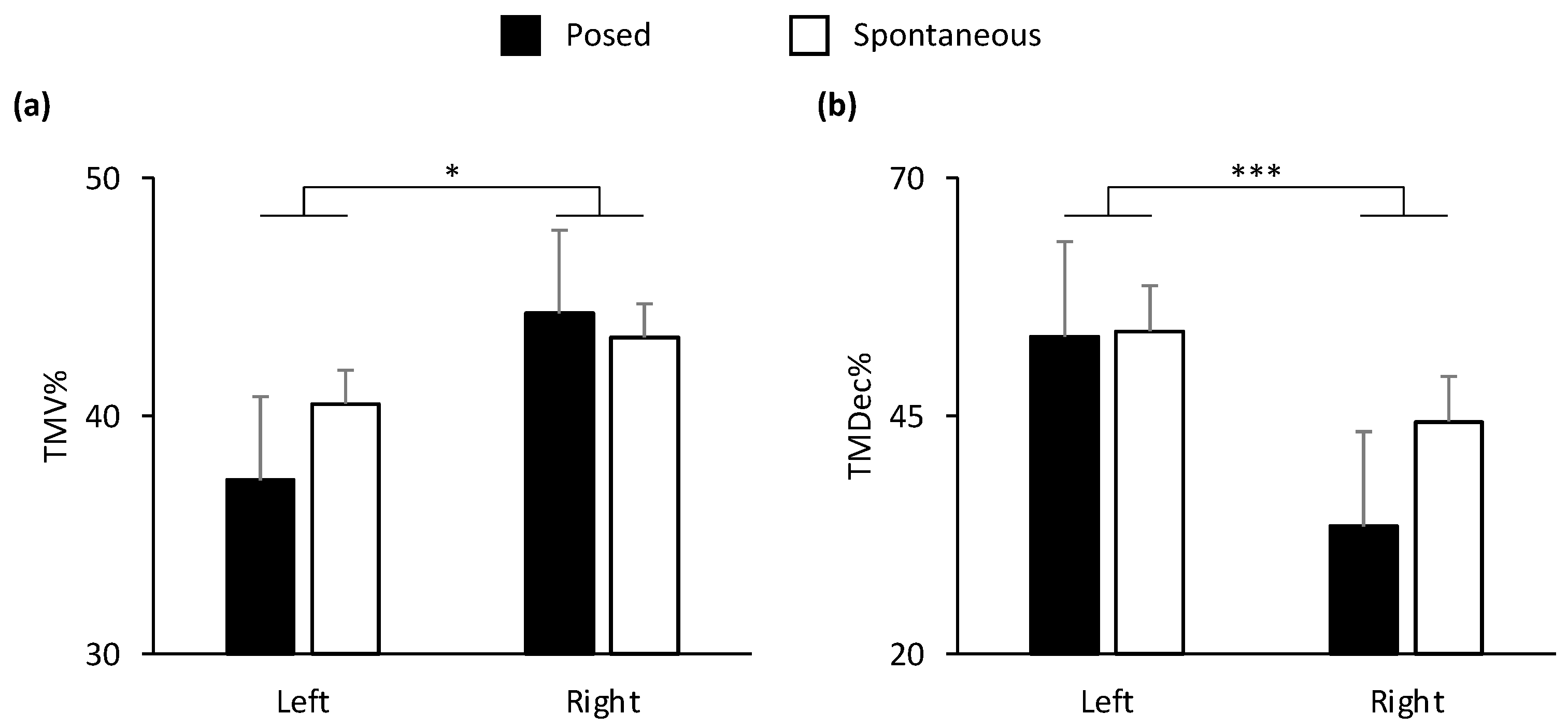
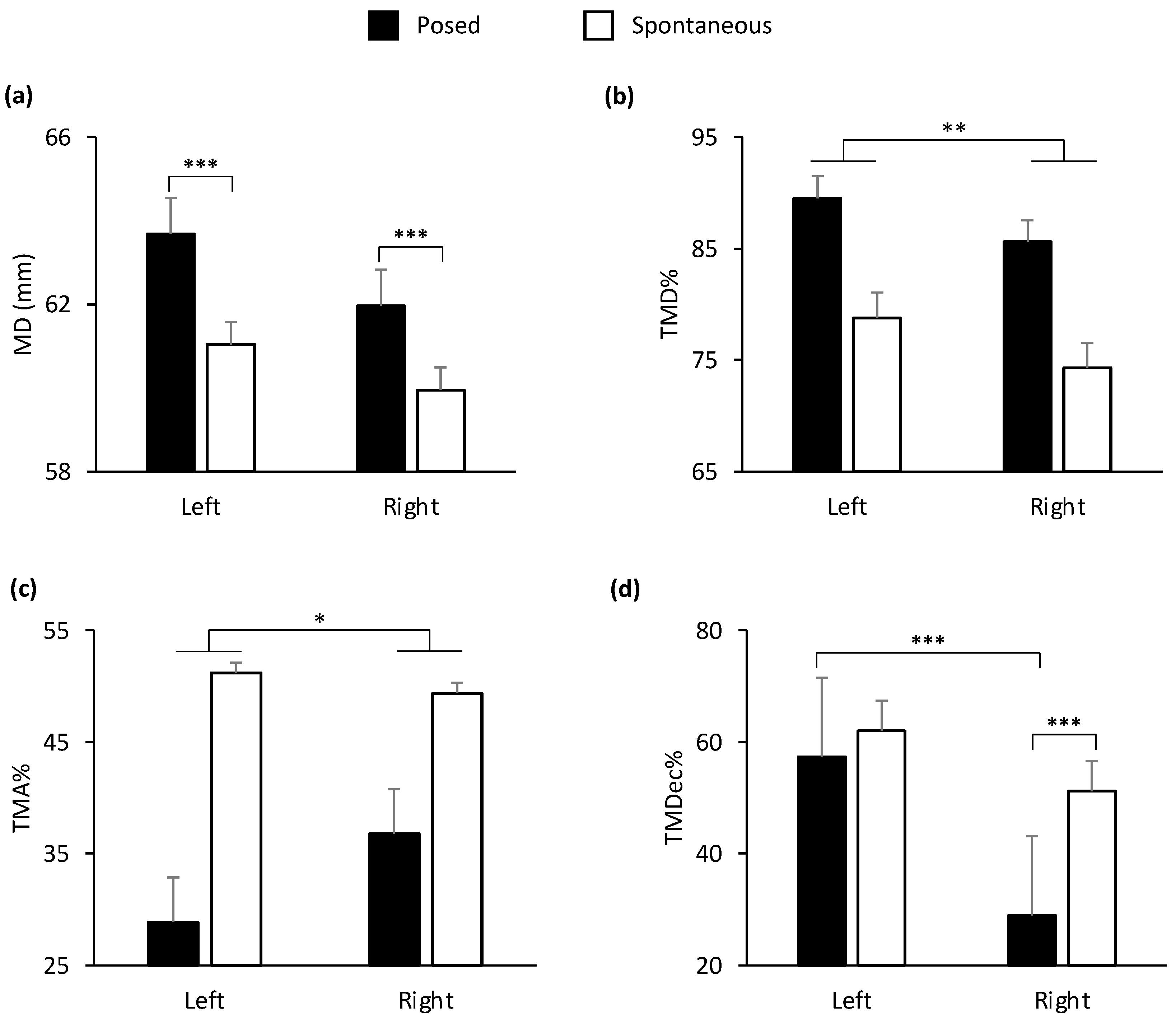
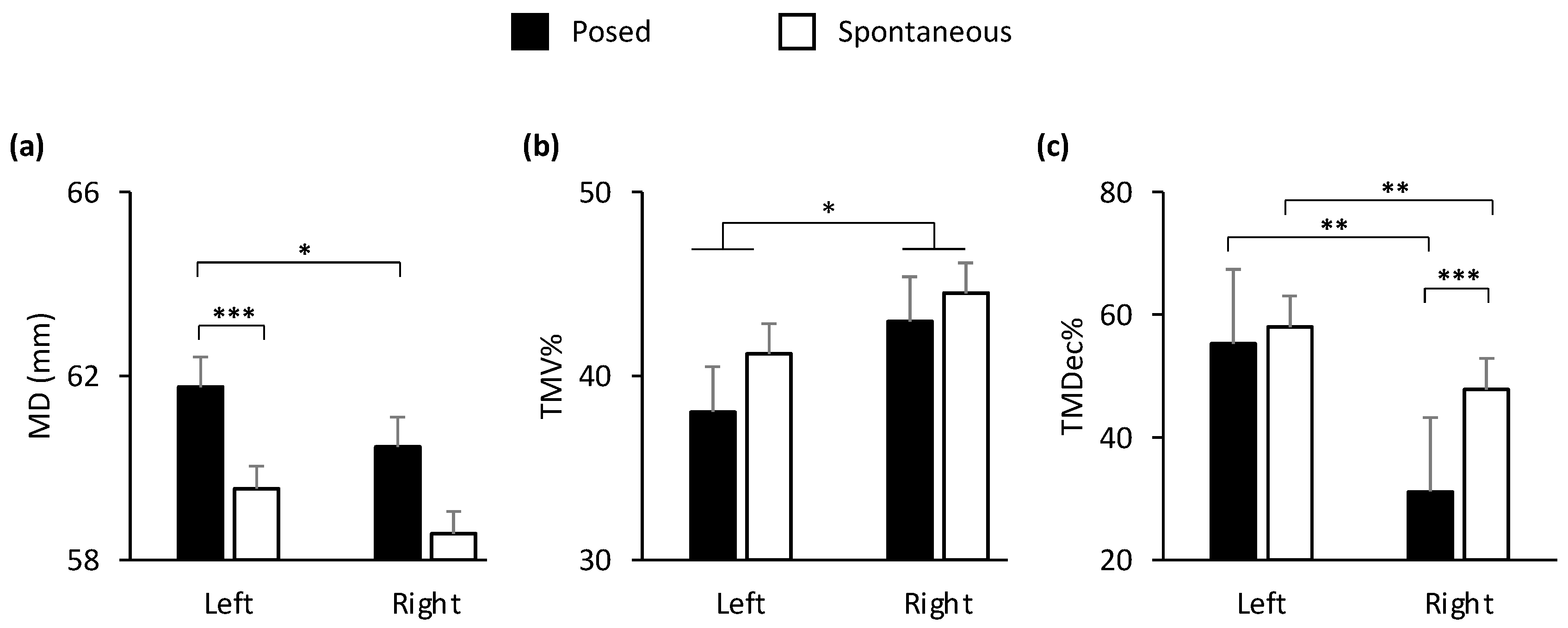
| Kinematic Parameters | Main Effect Condition | Main Effect Side of the Face | Interaction Condition by Side of the Face |
|---|---|---|---|
| Cheilions (CH) | |||
| MD | F(1,16) = 21.440, p < 0.001, VS-MPR = 161.690, η2p = 0.573 | F(1,16) = 3.007, p = 0.102, VS-MPR = 1.579, η2p = 0.158 | F(1,16) = 0.014, p = 0.908, VS-MPR = 1.000, η2p < 0.001 |
| DD | F(1,16) = 8.221, p = 0.011, VS-MPR = 7.325, η2p = 0.339 | F(1,16) = 1.882, p = 0.189, VS-MPR = 1.168, η2p = 0.105 | F(1,16) = 1.23, p = 0.305, VS-MPR = 1.016, η2p = 0.066 |
| MV | F(1,16) = 10.595, p = 0.005, VS-MPR = 13.958, η2p = 0.398 | F(1,16) = 0.636, p = 0.437, VS-MPR = 1.000, η2p = 0.038 | F(1,16) = 0.539, p = 0.473, VS-MPR = 1.000, η2p = 0.033 |
| MA | F(1,13) = 8.523, p = 0.012, VS-MPR = 6.952, η2p = 0.396 | F(1,13) = 0.365, p = 0.556, VS-MPR = 1.000, η2p = 0.027 | F(1,13) = 0.029, p = 0.868, VS-MPR = 1.000, η2p = 0.002 |
| MDec | F(1,13) = 6.491, p = 0.024, VS-MPR = 4.073, η2p = 0.333 | F(1,13) = 0.766, p = 0.397, VS-MPR = 1.000, η2p = 0.056 | F(1,13) = 0.192, p = 0.668, VS-MPR = 1.000, η2p = 0.015 |
| TMD% | F(1,16) = 5.670, p = 0.030, VS-MPR = 3.495, η2p = 0.262 | F(1,16) = 0.026, p = 0.873, VS-MPR = 1.000, η2p = 0.002 | F(1,16) = 1.142, p = 0.301, VS-MPR = 1.018, η2p = 0.067 |
| TMV% | F(1,16) = 0.120, p = 0.733, VS-MPR = 1.000, η2p = 0.007 | F(1,16) = 4.616, p = 0.047, VS-MPR = 2.548, η2p = 0.224 | F(1,16) = 0.530, p = 0.477, VS-MPR = 1.000, η2p = 0.032 |
| TMA% | F(1,14) = 5.670, p = 0.030, VS-MPR = 3.495, η2p = 0.262 | F(1,14) = 0.709, p = 0.414, VS-MPR = 1.000, η2p = 0.048 | F(1,14) = 0.562, p = 0.466, VS-MPR = 1.000, η2p = 0.039 |
| TMDec% | F(1,14) = 1.168, p = 0.298, VS-MPR = 1.020, η2p = 0.077 | F(1,14) = 24.37, p < 0.001, VS-MPR = 188.689, η2p = 0.632 | F(1,14) = 2.795, p = 0.117, VS-MPR = 1.467, η2p = 0.166 |
| Eyebrows (EB) | |||
| MD | F(1,16) = 12.298, p = 0.003, VS-MPR = 21.580, η2p = 0.435 | F(1,16) = 0.518, p = 0.482, VS-MPR = 1.000, η2p = 0.031 | F(1,16) = 1.411, p = 0.252, VS-MPR = 1.059, η2p = 0.081 |
| TMV% | F(1,14) = 10.083, p = 0.007, VS-MPR = 10.912, η2p = 0.419 | F(1,14) = 0.287, p = 0.601, VS-MPR = 1.000, η2p = 0.020 | F(1,14) = 0.413, p = 0.531, VS-MPR = 1.000, η2p = 0.029 |
| Kinematic Parameters | Main Effect Condition | Main Effect Side of the Face | Interaction Condition by Side of the Face |
|---|---|---|---|
| Cheilions (CH) | |||
| MD | F(1,19) = 29.400, p < 0.001, VS-MPR = 1135.133, η2p = 0.607 | F(1,19) = 5.681, p = 0.028, VS-MPR = 3.700, η2p = 0.230 | F(1,19) =6.452, p = 0.020, VS-MPR = 4.706, η2p = 0.253 |
| DD | F(1,19) = 21.393, p < 0.001, VS-MPR = 231.784, η2p = 0.530 | F(1,19) = 0.187, p = 0.670, VS-MPR = 1.000, η2p = 0.010 | F(1,19) = 0.080, p = 0.780, VS-MPR = 1.000, η2p = 0.004 |
| MV | F(1,19) = 29.728, p < 0.001, VS-MPR = 1205.041, η2p = 0.610 | F(1,19) = 3.451, p = 0.079, VS-MPR = 1.837, η2p = 0.154 | F(1,19) = 0.165, p = 0.689, VS-MPR = 1.000, η2p = 0.009 |
| MA | F(1,19) = 17.149, p < 0.001, VS-MPR = 88.406, η2p = 0.474 | F(1,19) = 0.102, p = 0.753, VS-MPR = 1.000, η2p = 0.005 | F(1,19) = 0.273, p = 0.608, VS-MPR = 1.000, η2p = 0.014 |
| MDec | F(1,19) = 18.450, p < 0.001, VS-MPR = 120.051, η2p = 0.493 | F(1,19) = 0.473, p = 0.500, VS-MPR = 1.000, η2p = 0.024 | F(1,19) = 0.895, p = 0.356, VS-MPR = 1.001, η2p = 0.045 |
| TMD% | F(1,19) = 26.586, p < 0.001, VS-MPR = 669.279, η2p = 0.583 | F(1,19) = 9.818, p = 0.005, VS-MPR = 12.910, η2p = 0.341 | F(1,19) = 0.036, p = 0.851, VS-MPR = 1.000, η2p = 0.002 |
| TMA% | F(1,19) = 17.956, p < 0.001, VS-MPR = 106.987, η2p = 0.486 | F(1,19) = 5.300, p = 0.033, VS-MPR = 3.282, η2p = 0.218 | F(1,19) = 4.089, p = 0.057, VS-MPR = 2.241, η2p = 0.177 |
| TMDec% | F(1,19) = 10.120, p = 0.005, VS-MPR = 14.076, η2p = 0.348 | F(1,19) = 46.466, p < 0.001, VS-MPR = 16685.144, η2p = 0.710 | F(1,19) = 9.707, p = 0.006, VS-MPR = 12.502, η2p = 0.338 |
| Kinematic Parameters | Main Effect Condition | Main Effect Side of the Face | 2-Way Interaction between Condition and Side of the Face |
|---|---|---|---|
| Cheilions (CH) | |||
| MD | F(1,35) = 49.138, p < 0.001, VS-MPR = 579,497.156, η2p = 0.584 | F(1,35) = 8.314, p = 0.007, VS-MPR = 10.987, η2p = 0.192 | F(1,35) = 4.106, p = 0.05, VS-MPR = 2.443, η2p = 0.105 |
| DD | F(1,35) = 27.775, p < 0.001, VS-MPR = 4382.16, η2p = 0.442 | F(1,35) = 1.380, p = 0.248, VS-MPR = 1.064, η2p = 0.038 | F(1,35) = 0.487, p = 0.490, VS-MPR = 1.000, η2p = 0.014 |
| MV | F(1,35) = 36.953, p < 0.001, VS-MPR = 42,283.314, η2p = 0.514 | F(1,35) = 3.246, p = 0.080, VS-MPR = 1.817, η2p = 0.085 | F(1,35) = 0.167, p = 0.685, VS-MPR = 1.000, η2p = 0.005 |
| MA | F(1,32) = 23.699, p < 0.001, VS-MPR = 1208.896, η2p = 0.425 | F(1,32) = 0.498, p = 0.485, VS-MPR = 1.000, η2p = 0.015 | F(1,32) = 0.031, p = 0.861, VS-MPR = 1.000, η2p < 0.001 |
| MDec | F(1,32) = 22.148, p < 0.001, VS-MPR = 791.644, η2p = 0.409 | F(1,32) =0.038, p = 0.847, VS-MPR = 1.000, η2p = 0.001 | F(1,32) = 0.898, p = 0.350, VS-MPR = 1.001, η2p = 0.027 |
| TMD% | F(1,35) = 27.941, p < 0.001, VS-MPR = 4576.896, η2p = 0.444 | F(1,35) =3.258, p = 0.080, VS-MPR = 1.825, η2p = 0.085 | F(1,35) = 1.128, p = 0.296, VS-MPR = 1.021, η2p = 0.031 |
| TMV% | F(1,35) =1.136, p = 0.294, VS-MPR = 1.022, η2p = 0.031 | F(1,35) = 6.551, p = 0.015, VS-MPR = 5.851, η2p = 0.158 | F(1,35) =0.200, p = 0.657, VS-MPR = 1.000, η2p = 0.006 |
| TMA% | F(1,33) = 20.198, p < 0.001, VS-MPR = 481.057, η2p = 0.380 | F(1,33) = 3.389, p = 0.075, VS-MPR = 1.900, η2p = 0.093 | F(1,33) = 3.683, p = 0.064, VS-MPR = 2.098, η2p = 0.100 |
| TMDec% | F(1,33) = 8.160, p = 0.007, VS-MPR = 10.181, η2p = 0.198 | F(1,33) = 66.159, p < 0.001, VS-MPR > 100,000, η2p = 0.667 | F(1,33) = 10.947, p = 0.002, VS-MPR = 26.596, η2p = 0.249 |
| Eyebrows (EB) | |||
| MD | F(1,35) = 6.535, p = 0.015, VS-MPR = 5.818, η2p = 0.157 | F(1,35) < 0.01, p = 0.986, VS-MPR = 1.000, η2p < 0.001 | F(1,35) = 2.596, p = 0.116, VS-MPR = 1.471, η2p = 0.069 |
Disclaimer/Publisher’s Note: The statements, opinions and data contained in all publications are solely those of the individual author(s) and contributor(s) and not of MDPI and/or the editor(s). MDPI and/or the editor(s) disclaim responsibility for any injury to people or property resulting from any ideas, methods, instructions or products referred to in the content. |
© 2023 by the authors. Licensee MDPI, Basel, Switzerland. This article is an open access article distributed under the terms and conditions of the Creative Commons Attribution (CC BY) license (https://creativecommons.org/licenses/by/4.0/).
Share and Cite
Straulino, E.; Scarpazza, C.; Spoto, A.; Betti, S.; Chozas Barrientos, B.; Sartori, L. The Spatiotemporal Dynamics of Facial Movements Reveals the Left Side of a Posed Smile. Biology 2023, 12, 1160. https://doi.org/10.3390/biology12091160
Straulino E, Scarpazza C, Spoto A, Betti S, Chozas Barrientos B, Sartori L. The Spatiotemporal Dynamics of Facial Movements Reveals the Left Side of a Posed Smile. Biology. 2023; 12(9):1160. https://doi.org/10.3390/biology12091160
Chicago/Turabian StyleStraulino, Elisa, Cristina Scarpazza, Andrea Spoto, Sonia Betti, Beatriz Chozas Barrientos, and Luisa Sartori. 2023. "The Spatiotemporal Dynamics of Facial Movements Reveals the Left Side of a Posed Smile" Biology 12, no. 9: 1160. https://doi.org/10.3390/biology12091160






